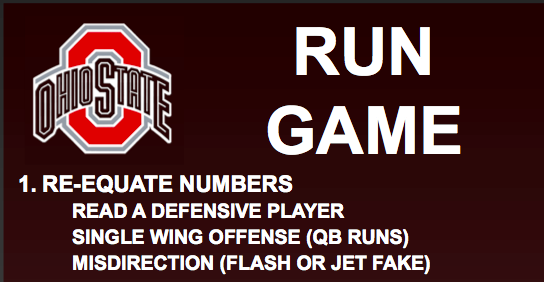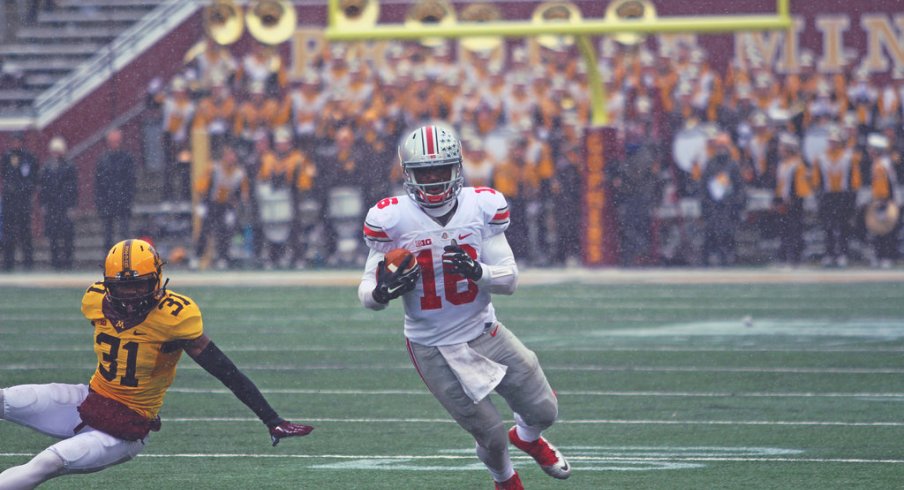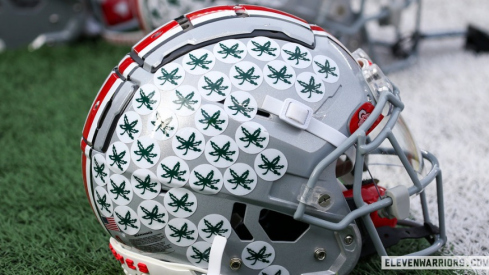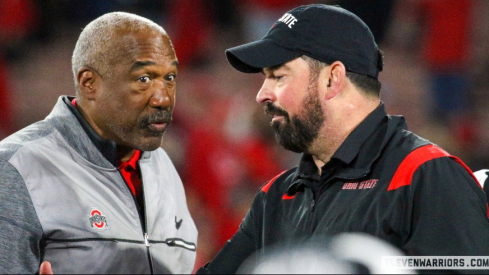Ohio State's win over Minnesota was far harder than needed, as the Buckeyes overcame turnovers, poor special teams, and the weather to control the game against the Golden Gophers.
To do so, Ohio State utilized JT Barrett as a runner to gain an additional defender against Minnesota's aggressive defensive fronts. And the Buckeye defense overcame several explosive runs by rendering the Golden Gophers' run game inefficient and controlling third down.
Go for Broke
The Golden Gopher coaching staff employed the Virginia Tech strategy. Minnesota generally aligned eight to nine defenders within ten yards in the box and one or zero deep safeties. At the snap, the front often stunted or twisted in an attempt to confuse the Buckeyes' offensive line, and frequently deployed cover 0 or cover 1 man coverages.

The high risk strategy had some success in limiting the Buckeyes' first down run game, often placing Ohio State in third and medium to long.
But it also permitted Ohio State to create explosive plays upon getting to the second level.
Punch-Counter Punch
Urban Meyer and Tom Herman countered with their basic responses to no deep or one high defense. To throw the Buckeyes often utilized trips. This forced Minnesota to roll their deep safety to the three wide receivers and opened the middle of the field.
The Buckeyes ran slant and hitch routes against soft man from their play action gap protection scheme. And when Minnesota used tight coverage Ohio State responded with sprint out spacing routes and the screen game, to confuse and rub off man defenders.
To run, Meyer and Herman sought ways to re-equate numbers and gain an additional blocker against extra box defenders.

This primarily came in the form of using the tailback as a lead blocker. For instance, from 12 personnel the Buckeyes ran its unbalanced pop pass to Jalin Marshall.
But the primary -- and most effective -- response was utilizing Barrett on lead quarterback runs.
To do so, the Buckeyes utilized a wrinkle -- faking a quick toss -- to hold the safety and create angles on linebackers. Off the fake, Barrett ran both tight zone and power (as well as play action).
The Buckeyes also faked the pop pass to run lead quarterback counter trey.
The Equalizer
Much has been said about Barrett and the offensive line's improvement in the passing game since the Virginia Tech loss. And the praise is deserved.
But perhaps the biggest difference for the Buckeyes in playing such run-focused looks is Barrett's growth as a runner. Against Virginia Tech, the Hokies dared Barrett to run. But Meyer and Herman were not as confident using Barrett as a runner. And Barrett did not run with the same aggressiveness. This resulted in an inability to take pressure off the inside run game and respond to zero high safety looks.
But Barrett is now an extremely effective runner because he uses his vision and quickly gets upfield. This permits Ohio State to run the football against nine man fronts, taking pressure off the inside run game.
And it allows the Buckeyes to remain balanced on third down. Against Minnesota, Ohio State was nine of thirteen on third downs -- despite having to gain an average of 6.2 yards. Much of this was attributable to designed quarterback runs to Barrett -- including 38 and 86 yarders.
And Barrett is not just efficient. He has 17 runs of at least 15 yards, making him the Buckeyes' primary threat for explosive plays in the run game.
It was the Best of Times, it was the Worst of Times
It was a bit of a Jeckyll and Hyde effort by the Ohio State defense against Minnesota's run-heavy scheme. Although the Gophers frequently used 22 personnel (a fullback and two tight ends), Chris Ash generally did not bring another safety into the box. Instead, Ash continued with his base 4-3 over, cover 4 defense.
And the Buckeyes were largely successful. The Ohio State defense forced four three and outs and limited the Gophers to five of fourteen on third down and a 48% run success rate.
The Ohio State defense succeeded when they kept the Minnesota run game behind the chains by controlling the line of scrimmage.
But the Buckeyes permitted Minnesota to run for 218 yards by surrendering chunk plays. This largely resulted from occasional poor angles by Ohio State inside linebackers and poor tackling in the secondary.
For instance, Will linebacker Josh Perry's failure to maintain his gap integrity permitted several cutback lanes. Perry appeared to be keying the fullback. So when Minnesota ran split zone with the fullback blocking away from the play, Perry would take a false step and leave an open gap.
For his part, Mike Curtis Grant often overran the power play. Here, Joey Bosa correctly wrong-arms the kick out block to force the ball outside. But Minnesota tailback David Cobb was able to cut inside because Grant failed to leverage the football.
And Safety Tyvis Powell struggled at times with coming downhill and tackling the talented Cobb in space.
Ash does not have his safeties play as aggressive against the run as does Michigan State's Pat Narduzzi with his quarters defense. Ash's goal is to force the football inside where the inside linebackers can leverage the football and make tackles. The safeties' role is to fill the allies, in theory rendering the defense less risky than Narduzzi's.
But when the inside linebackers take poor pursuit angles and the safety fails to make the tackle, the result is a big gain.
Consequently, at time Cobb gained yardage once he got past the Buckeye defensive line.
So inconsistent play at linebacker and lack of depth on the defensive line -- particularly in the form of a true gap-plugging nose guard -- has left the Buckeye defense susceptible to lapses against the run. But it is undeniable that the Ohio State defense is much improved under Ash. And the Buckeye starting defense line is sufficiently talented that they render opposing offenses inconsistent in their success rate, forcing opposing offenses to score through explosive plays.
So it is an overstatement to say that the run defense is a serious concern. The Buckeyes have faced two strong downhill run games after not facing one this season. And although both Michigan State and Minnesota gained yards rushing, neither could consistently mount drives running the football.
clean it up
The Buckeyes had mistakes on both sides of the football. For instance, the Ohio State wide receivers had several harmful drops. But most harmful was also the most obvious -- turnovers.
The Buckeyes' three turnovers were particularly damaging. The first turnover was a constraint play action vertical route where Meyer indicated that Barrett needed to throw the football inside where the receiver could run to the football.
But Marshall's two fumbles were self-inflicted wounds. Marshall's first turnover resulted in a fourteen point swing. And his second fumble prevented Ohio State from icing away an easy victory.
All of Minnesota's touchdowns came off turnovers. The Buckeye defense needed to respond better to such quick turnaround situations. But unfortunately for Ohio State, it kept the Gophers in a game the Buckeyes otherwise controlled.
The Buckeyes also need to fix their flagging special teams. For the second straight week the Ohio State special teams were a net negative.
Marshall's fumble is the most obvious. But the Buckeye kickoff and punt units also did not flip the field. The result was that Ohio State provided Minnesota an average start position at the 35 yard line and again lost the field position battle -- an area where they had previously succeeded. The Buckeyes need to use their return home against Indiana to shore up these miscues.


